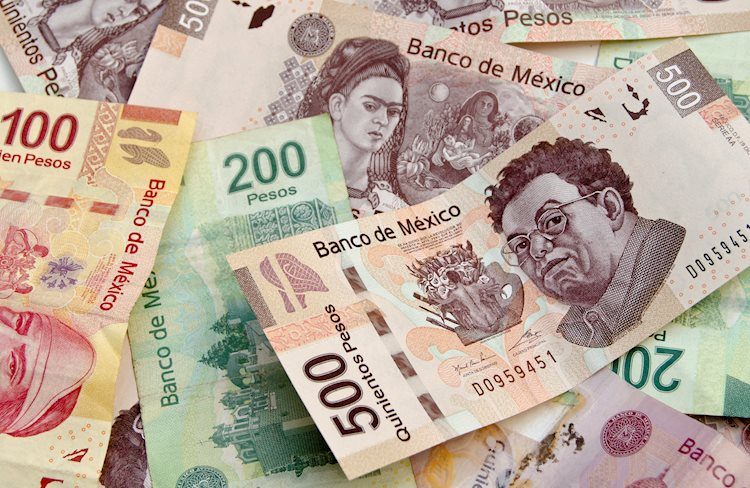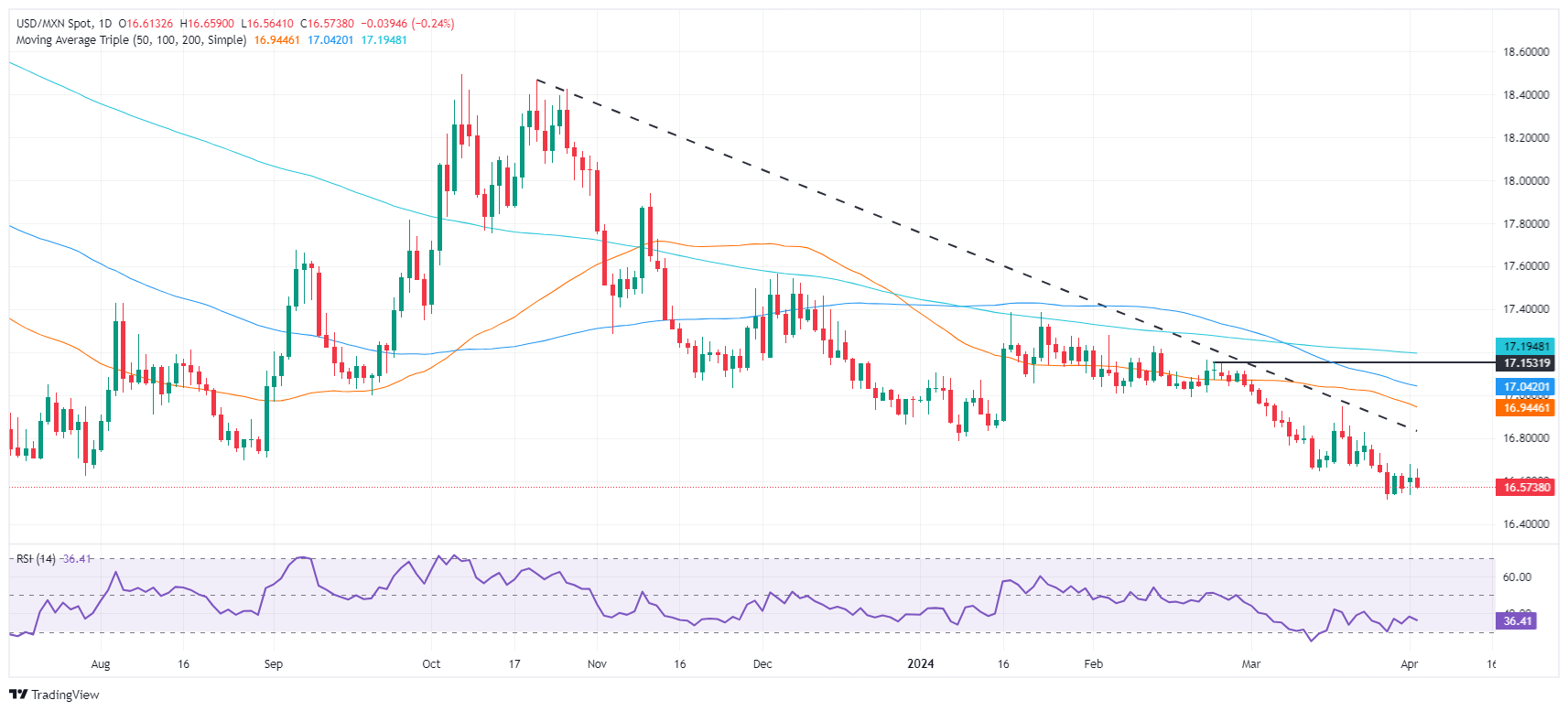- Mexican Peso climbs on Greenback as Mexico’s stable Business Confidence overshadows climbing US Treasury yields.
- Mexico’s economic schedule will feature Gross Fixed Investment and upcoming Banxico minutes.
- Despite positive US job and factory order figures, the Greenback’s rally loses momentum.
The Mexican Peso recovered some ground against the US Dollar on Tuesday after upbeat economic data from the United States (US), while Mexico’s Business Confidence remained unchanged. Although US Treasury yields climb, the Greenback fails to gain traction. The USD/MXN trades at 16.58, down 0.2%.
Mexico’s economic docket is busy during the week. The National Statistics Agency (INEGI) revealed that business confidence was unchanged at 54.3 in February yet remained at high levels, the last seen in almost eleven years. Traders will be eyeing the release of Gross Fixed Investment figures on Wednesday, followed by the release of the latest meeting minutes for the Bank of Mexico (Banxico).
Across the border, job vacancy figures for February exceeded the downwardly revised data for the previous month, while Factory Orders improved for the same period. Following the data, US Treasury yields climbed, but the US Dollar remains on the defensive.
Daily digest market movers: Mexican Peso ignores upbeat US data and rallies
- Digging deeper into Mexico’s Business Confidence data, confidence in the current economic outlook decreased from 53.7 to 53.1. In regard to expectations for the future, the sub-component cooled from 56.2 to 56.1.
- Mexico´s economic outlook remains solid as manufacturing activity expands, though at a slower pace than in January. That, coupled with strong business optimism, could underpin the Mexican currency, which is at risk of depreciating if Banxico continues to lower rates, diminishing the interest rate differential with the US.
- Last week, Banxico Governor Victoria Rodriguez Ceja remained dovish despite acknowledging that the battle against inflation hasn’t been won. She added, “When macroeconomic conditions and the inflationary outlook allow us to make additional adjustments to the reference rate to the one we already have, I consider that they would be gradual.”
- The US Bureau of Labor Statistics (BLS) revealed that the Job Openings and Labor Turnover (JOLTS) summary report showed that vacancies had changed a little in February. Figures came at 8.756 million, exceeding the previous month’s downward revised numbers of 8.748 million and estimates of 8.75 million.
- The US Census Bureau revealed that Factory Orders for February rose by 1.4% after a -3.4% showing in January, exceeding estimates of 1%.
- Tuesday’s data, along with manufacturing activity expanding in March, portrays a strong economic outlook for the US economy. Although Federal Reserve Chair Jerome Powell pivoted last December, data suggests that it’s too early to begin easing policy.
- Regarding future interest rate expectations of the Fed, the CME FedWatch Tool suggests that traders see a 58% chance of the US central bank cutting borrowing costs.
- Chair Powell said at San Francisco Fed: “The fact that the US economy is growing at such a solid pace, the fact that the labor market is still very, very strong, gives us the chance to just be a little more confident about inflation coming down before we take the important step of cutting rates.”
Technical analysis: Mexican Peso buyers eye October 2015 high of 16.32
The USD/MXN consolidates within the 16.50/16.65 range for the latest five trading days. The Relative Strength Index (RSI) sees sellers’ momentum fading, offering buyers an opportunity. The Mexican Peso is at levels last seen in eight years, making US Dollar longs more attractive, as the pair sits around last year’s low.
If USD/MXN buyers enter, they must lift the exchange rate above the 16.70 area. Once cleared, the next stop would be the 50-day Simple Moving Average (SMA) at 16.94, with further upside seen at the 100-day SMA at 17.04, ahead of the 200-day SMA at 17.18
On the flip side, the USD/MXN might extend its losses if it remains below 16.62. A breach of the current year-to-date low of 16.51 can pave the way toward the October 2015 swing low of 16.32.
Mexican Peso FAQs
The Mexican Peso (MXN) is the most traded currency among its Latin American peers. Its value is broadly determined by the performance of the Mexican economy, the country’s central bank’s policy, the amount of foreign investment in the country and even the levels of remittances sent by Mexicans who live abroad, particularly in the United States. Geopolitical trends can also move MXN: for example, the process of nearshoring – or the decision by some firms to relocate manufacturing capacity and supply chains closer to their home countries – is also seen as a catalyst for the Mexican currency as the country is considered a key manufacturing hub in the American continent. Another catalyst for MXN is Oil prices as Mexico is a key exporter of the commodity.
The main objective of Mexico’s central bank, also known as Banxico, is to maintain inflation at low and stable levels (at or close to its target of 3%, the midpoint in a tolerance band of between 2% and 4%). To this end, the bank sets an appropriate level of interest rates. When inflation is too high, Banxico will attempt to tame it by raising interest rates, making it more expensive for households and businesses to borrow money, thus cooling demand and the overall economy. Higher interest rates are generally positive for the Mexican Peso (MXN) as they lead to higher yields, making the country a more attractive place for investors. On the contrary, lower interest rates tend to weaken MXN.
Macroeconomic data releases are key to assess the state of the economy and can have an impact on the Mexican Peso (MXN) valuation. A strong Mexican economy, based on high economic growth, low unemployment and high confidence is good for MXN. Not only does it attract more foreign investment but it may encourage the Bank of Mexico (Banxico) to increase interest rates, particularly if this strength comes together with elevated inflation. However, if economic data is weak, MXN is likely to depreciate.
As an emerging-market currency, the Mexican Peso (MXN) tends to strive during risk-on periods, or when investors perceive that broader market risks are low and thus are eager to engage with investments that carry a higher risk. Conversely, MXN tends to weaken at times of market turbulence or economic uncertainty as investors tend to sell higher-risk assets and flee to the more-stable safe havens.

